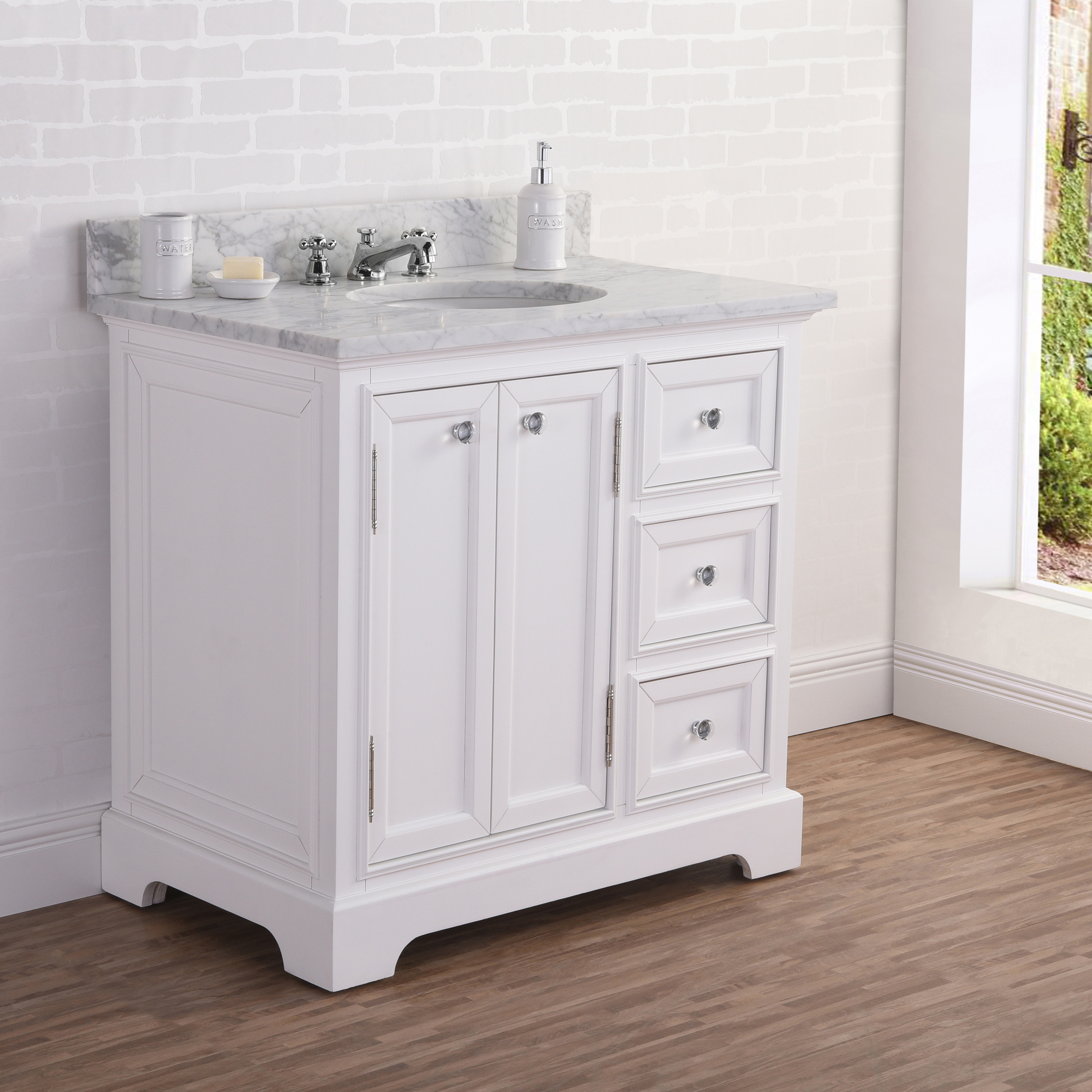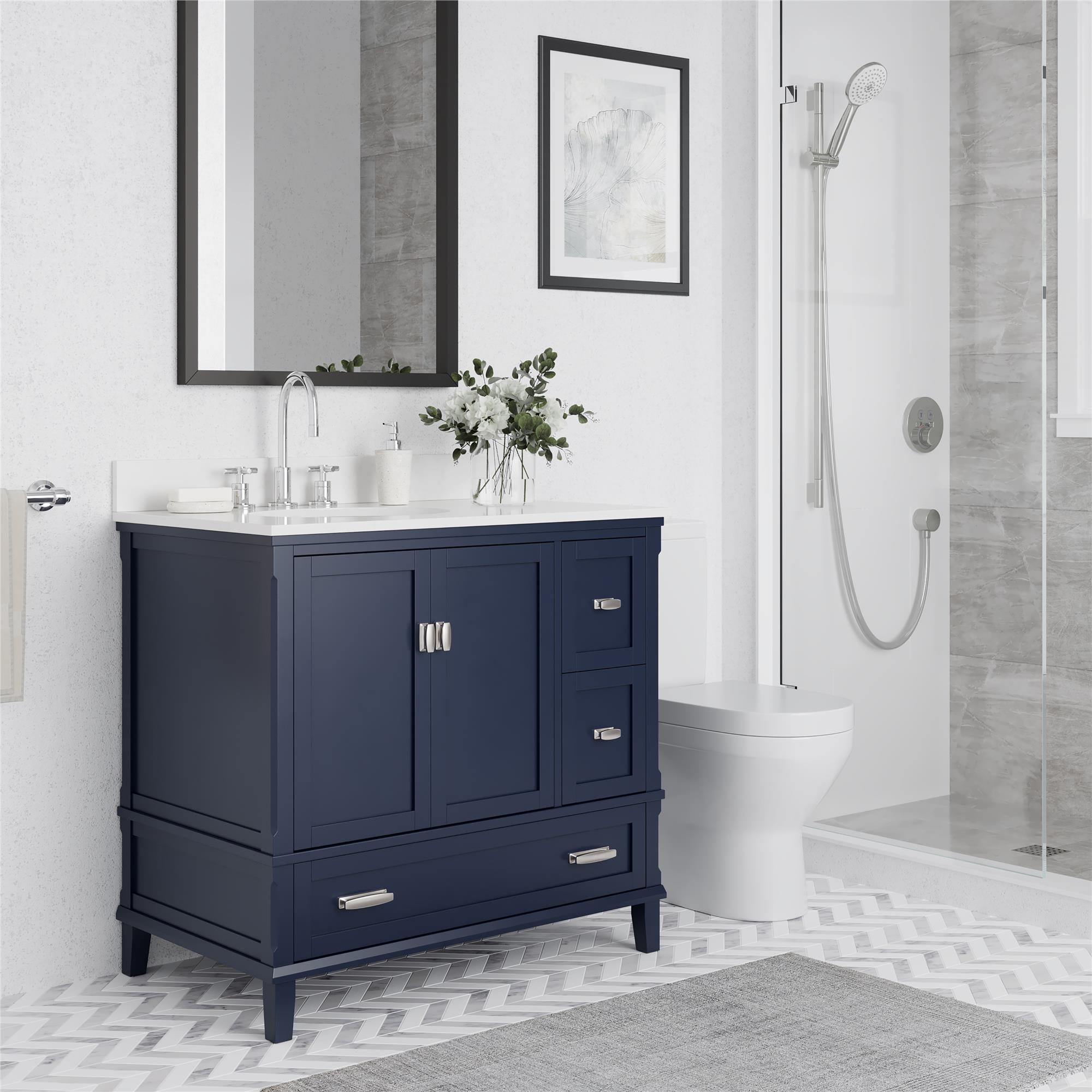Choosing the Right 36″ Bathroom Vanity: 36 Bathroom Vanity With Bottom Drawer

A 36″ bathroom vanity is a popular choice for smaller bathrooms, offering a balance between functionality and space efficiency. This size is compact enough to fit comfortably in tighter spaces, while still providing ample storage and countertop space.
Advantages and Disadvantages of a 36″ Bathroom Vanity
A 36″ bathroom vanity offers several advantages, including its compact size, which makes it suitable for smaller bathrooms. It can also accommodate a single sink, making it an ideal choice for a single-person bathroom or a guest bathroom. However, there are also some disadvantages to consider, such as limited storage space compared to larger vanities and potential difficulty in fitting larger plumbing fixtures.
Materials Used for 36″ Bathroom Vanities
Bathroom vanities come in a variety of materials, each with its own unique properties.
- Wood: Wood vanities are known for their durability, elegance, and natural beauty. They can be stained or painted to match any décor. Popular wood choices include oak, maple, cherry, and walnut. However, wood vanities can be more expensive than other options.
- Laminate: Laminate vanities are a more affordable option that offers good durability and resistance to moisture. They come in a wide range of colors and finishes, mimicking the look of wood or stone. However, laminate vanities can be less scratch-resistant and may not be as aesthetically pleasing as wood.
- Acrylic: Acrylic vanities are a modern and sleek option that is highly resistant to scratches and stains. They are also easy to clean and maintain. However, acrylic vanities can be more expensive than laminate vanities and may not be as durable as wood.
Choosing the Right Style and Finish
The style and finish of your 36″ bathroom vanity should complement the overall design of your bathroom.
- Traditional Style: Traditional bathroom vanities typically feature ornate details, such as carvings, molding, and distressed finishes. They often come in warm wood tones, such as cherry or mahogany.
- Modern Style: Modern bathroom vanities are characterized by clean lines, simple shapes, and minimalist details. They often come in sleek finishes, such as high-gloss white or black.
- Contemporary Style: Contemporary bathroom vanities blend elements of traditional and modern styles, creating a sophisticated and timeless look. They often feature natural wood finishes, metallic accents, and geometric shapes.
Comparison of 36″ Bathroom Vanity Brands
The following table compares different 36″ bathroom vanity brands based on price, features, and customer reviews.
| Brand | Price Range | Features | Customer Reviews |
|---|---|---|---|
| Brand A | $500 – $1000 | Solid wood construction, soft-close drawers, double sink | 4.5 stars |
| Brand B | $300 – $700 | Laminate construction, single sink, open shelving | 4 stars |
| Brand C | $700 – $1500 | Acrylic construction, single sink, integrated countertop | 4.2 stars |
Maximizing Storage and Functionality

A 36″ bathroom vanity with a bottom drawer offers a perfect balance of style and practicality. The bottom drawer provides ample storage space for all your bathroom essentials, while the vanity’s compact size ensures it fits comfortably in most bathrooms. To maximize storage and functionality, consider the different types of storage options available and how to best utilize them.
Types of Storage Options
A 36″ bathroom vanity with a bottom drawer typically features various storage compartments designed to accommodate your bathroom essentials. These can include:
- Bottom Drawer: The primary storage space, offering a large, open area for towels, toiletries, and other items.
- Cabinet Doors: Behind the doors, you might find shelves or additional drawers, providing organized storage for smaller items.
- Open Shelves: Some vanities feature open shelves, ideal for displaying decorative items or storing frequently used items.
- Built-in Drawers: Depending on the vanity design, you might find smaller drawers within the vanity, offering a convenient way to store items like makeup brushes, jewelry, or hair accessories.
Benefits of a Bottom Drawer
A bottom drawer offers several benefits for bathroom storage:
- Accessibility: The bottom drawer provides easy access to items stored inside, unlike shelves or cabinets that require bending or reaching.
- Organization: The drawer’s large, open space allows for efficient organization. You can use drawer dividers, trays, or baskets to separate and categorize items.
- Hidden Storage: The drawer keeps items out of sight, maintaining a clean and clutter-free appearance in your bathroom.
Organizing a 36″ Bathroom Vanity with a Bottom Drawer, 36 bathroom vanity with bottom drawer
To maximize storage in your 36″ bathroom vanity with a bottom drawer, consider these tips:
- Categorize and Sort: Divide items into categories, such as toiletries, towels, hair care products, and medications. This makes it easier to find what you need.
- Utilize Drawer Dividers: Drawer dividers help to create separate compartments, keeping items organized and preventing them from shifting around.
- Use Baskets and Trays: Baskets and trays can be used to group similar items, adding visual appeal and making it easier to access specific items.
- Vertical Storage: Utilize vertical space by using stackable containers or drawer organizers. This allows you to store more items in a limited space.
- Maximize Shelf Space: If your vanity has shelves, use them for storing items that are not frequently used or can be stacked.
Visual Guide: Maximizing Storage
Imagine a 36″ bathroom vanity with a bottom drawer. Here’s how you can maximize its storage potential:
Bottom Drawer: Use a drawer divider to create separate compartments for towels, toiletries, and hair care products. Store bulky items like towels at the back and smaller items like makeup brushes in the front.
Cabinet Doors: If your vanity has cabinet doors, utilize shelves for storing extra towels, cleaning supplies, or infrequently used items.
Open Shelves: Display decorative items or store frequently used items like hand towels or scented candles.
Built-in Drawers: If your vanity has built-in drawers, use them to store jewelry, hair accessories, or other small items.
Installation and Maintenance

Installing a 36″ bathroom vanity with a bottom drawer is a straightforward process, but it’s crucial to follow the correct steps for a successful and long-lasting installation. This section will guide you through the installation process, provide essential tips for maintenance, and address common challenges you might encounter.
Tools and Materials
The following tools and materials are necessary for installing a 36″ bathroom vanity with a bottom drawer:
- Level: Ensures the vanity is installed horizontally.
- Tape measure: Accurately measures the vanity’s dimensions and the installation space.
- Stud finder: Locates wall studs for secure mounting.
- Pencil: Marks the installation points on the wall.
- Drill: Creates pilot holes for screws and installs the vanity.
- Screwdriver: Tightens screws securely.
- Safety glasses: Protects your eyes from debris.
- Utility knife: Cuts caulk and other materials.
- Caulk gun: Applies sealant around the vanity.
- Silicone caulk: Seals gaps between the vanity and the wall.
- Plumber’s putty: Seals the sink drain.
- Adjustable wrench: Tightens and loosens plumbing fixtures.
- Pliers: Assists with plumbing installations.
- Vanity screws: Securely attach the vanity to the wall.
- Plumbing supplies: Includes faucet, drain assembly, and supply lines.
- Instructions: Provides detailed steps and specifications for your specific vanity.
Installation Steps
- Prepare the Installation Area: Clear the area around the vanity and remove any existing fixtures or cabinets. Ensure the floor is level and clean.
- Locate Wall Studs: Use a stud finder to identify the wall studs where you will mount the vanity. Mark the stud locations on the wall with a pencil.
- Install the Vanity Base: Place the vanity base against the wall, ensuring it is level. Mark the screw locations on the wall using the provided template or by measuring the distance between the pre-drilled holes on the vanity base. Drill pilot holes at the marked locations. Secure the vanity base to the wall studs using the provided screws.
- Install the Sink: If the vanity comes with a pre-installed sink, skip this step. If not, follow the manufacturer’s instructions for installing the sink. Typically, this involves placing the sink on the vanity top, aligning it, and securing it with clamps or screws.
- Connect Plumbing Fixtures: Connect the faucet, drain assembly, and supply lines according to the manufacturer’s instructions. Ensure all connections are tight and secure.
- Install the Vanity Top: Place the vanity top on the base, ensuring it is aligned and level. Secure the top to the base using the provided hardware.
- Seal Gaps: Apply silicone caulk around the vanity top and the wall to prevent water damage. Smooth the caulk with a damp finger or a tool specifically designed for this purpose.
- Test the Installation: Turn on the water supply and check for leaks. If there are leaks, tighten the connections or reapply sealant as needed.
Common Installation Challenges and Solutions
- Uneven Walls: Uneven walls can make it difficult to install the vanity level. Use shims or wedges to adjust the vanity’s position until it is level. Alternatively, consider using a wall-mounted vanity, which eliminates the need for wall studs.
- Incorrect Stud Location: If the vanity doesn’t align with the wall studs, you can use heavy-duty toggle bolts to secure the vanity to the wall. However, ensure the toggle bolts are rated for the weight of the vanity.
- Plumbing Issues: Plumbing issues, such as leaks or improper connections, can arise during installation. It’s essential to carefully follow the manufacturer’s instructions and use the appropriate plumbing materials. Consult a plumber if you encounter any significant plumbing problems.
Maintaining a 36″ Bathroom Vanity
- Clean Regularly: Wipe down the vanity top and sink with a mild cleaner and a soft cloth after each use. Avoid harsh chemicals or abrasive cleaners, as they can damage the finish.
- Dry Thoroughly: After cleaning, dry the vanity top and sink completely to prevent water spots and mildew growth.
- Clean the Drawer: Regularly clean the inside of the drawer to prevent dirt and grime buildup. Use a damp cloth and mild cleaner.
- Check for Leaks: Inspect the vanity and plumbing connections for leaks regularly. Promptly address any leaks to prevent water damage.
- Lubricate Hardware: Lubricate the drawer slides and hinges with a light oil to ensure smooth operation.
- Avoid Overloading: Avoid overloading the drawer or placing heavy objects on the vanity top to prevent damage.
